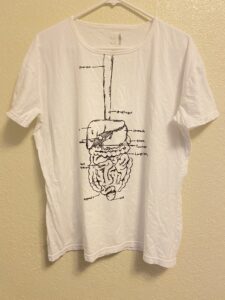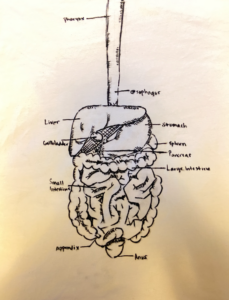

The digestive system is an imperative part of the human body that holds many roles in helping maintain equilibrium. The four primary functions of the digestive system include ingestion, digestion, absorption, and defecation. Ingestion includes the intake of nutrients, digestion includes the breakdown of larger molecules in smaller ones, absorption of the intake of nutrients into cells, digestive tract, and bloodstream, and finally, defecation includes the elimination of undigested waste. Understanding the digestive system plays an important role in researching and treating various ailments of the human body, especially in clinical practices. For this STEAM project, I chose to highlight these functions by showing the pathway of the digestive system in a fun and artistic way by painting the organs of the digestive system on a T-Shirt to display what would be seen in the human body in the torso where the shirt overlays.
First, the esophagus is highlighted as the first organ. This organ is used to help transport substances from the mouth to the stomach and prevent gastroesophageal reflux with the esophageal sphincter. This organ prevents the backflow of acid from refluxing back through the pathway and potentially deteriorating the esophagus. It is lined with mucosa and is located posterior to the trachea and in anterior to the heart.
Next is the liver. The liver’s primary function is the filtration of blood, but it also detoxifies and metabolizes drugs and chemicals as well as secretes bile. Similarly, located below the liver, the gallbladder is highlighted. The gallbladder stores and concentrates bile, which is used as a digestive enzyme. In researching the functions of the liver, I was surprised to find that the current infection facing our world, SARS-Cov-2, is a major risk to those undergoing endoscopies and especially those with liver transplants because they are immunosuppressed (Crespo et al 2020).
The stomach is a hollow organ used as a container of sorts to help mix food with digestive enzymes to help breakdown food into its chemical components to be used by the body in different areas. The stomach lining secretes acid and enzymes that break down the substances in the stomach after ingestion (Hoyle 1998).
The other two majorly highlighted organs include the small and large intestines. The large intestine primarily absorbs water and electrolytes, produces and absorbs vitamins, and forming and moving feces towards the rectum (Boland 2015). It includes the transverse colon, ascending colon, descending colon, cecum, sigmoid colon, appendix, rectum, and anal canal. The small intestine similarly absorbs nutrients, but it also receives the pancreatic secretions and bile to aid in absorption. The small intestine includes the duodenum, jejunum, and the ileum.
Also included in this diagram shirt are the pancreas and the spleen. The spleen aids in blood filtration, removing old or damaged red blood cells. The pancreas aids in converting food to fuel for cells. The pancreas’ functions are both exocrine and endocrine, helping in digestion and in blood sugar regulation.
References:
Boland, M. (2016). Human digestion – a processing perspective. Journal of the Science of Food
and Agriculture, 96(7), 2275-2283. doi:10.1002/jsfa.7601
Crespo, J., Iglesias-García, J., Val, J. E., García, F. G., Miguel, Á G., Carrillo, C. F., . . . Martínez, E.
- (2020). COVID-19 and the digestive system: Protection and management during the SARS-CoV-2 pandemic. Revista Española De Enfermedades Digestivas,112. doi:10.17235/reed.2020.7128/2020
Hoyle, T. (1997). The digestive system: Linking theory and practice. British Journal of
Nursing, 6(22), 1285-1291. doi:10.12968/bjon.1997.6.22.1285

I like this article about The Digestive System Shirt, it has a lot of info I need to know, thanks for the explanation and for sharing these tips